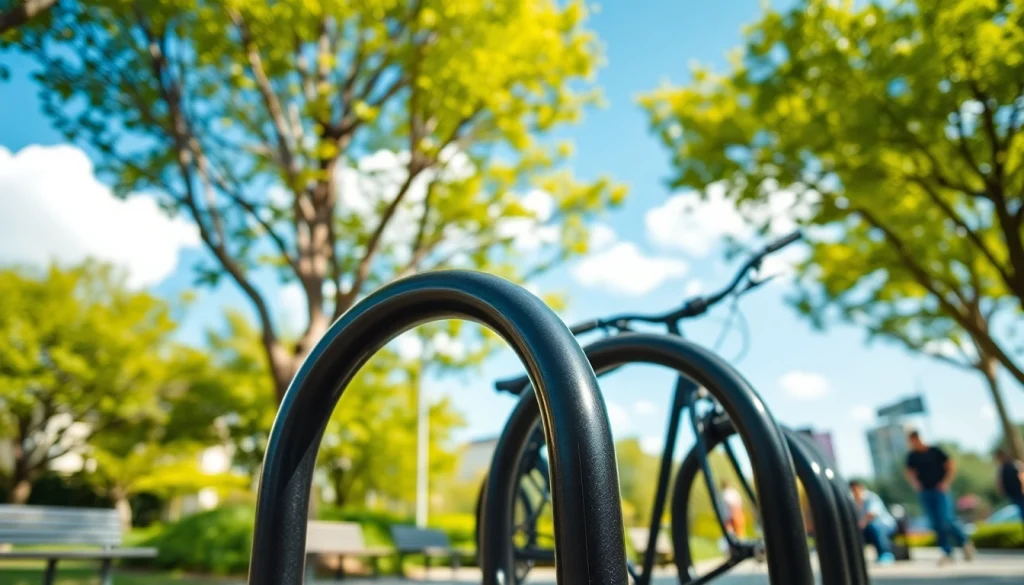Understanding the Importance of a Designer Bike Rack
What is a Designer Bike Rack?
A Designer bike rack is not just a functional piece of hardware; it is a convergence of style, utility, and artistry. Unlike standard bike racks, designer bike racks are created with a focus on aesthetic appeal, aimed at blending seamlessly into both urban and rural landscapes. These racks can be customized in various shapes, colors, and materials, making them eye-catching and appealing to users. Whether formed into sleek lines that echo modern architecture or crafted to resemble natural elements, the designer bike rack epitomizes the idea that functionality and style can coexist.
Benefits of Using a Designer Bike Rack
The benefits of utilizing a designer bike rack extend far beyond their visual appeal. Firstly, they contribute to urban design by enhancing public spaces and encouraging cycling as a sustainable mode of transport. Their thoughtful conditioning promotes eco-friendliness among individuals and organizations alike. Moreover, a well-placed designer bike rack makes cycling more accessible, potentially increasing the use of bikes for commuting and recreational purposes.
Designers often incorporate practical features such as anti-theft mechanisms and easy access, ensuring that bikes are secured efficiently while also being convenient for the user. Additionally, a unique bike rack can serve as a focal point in a community, inviting conversations and interactions while reinforcing a commitment to a modern lifestyle.
Common Materials Used in Designer Bike Rack Construction
Designer bike racks can be constructed using a variety of materials, each offering unique benefits. Steel and aluminum are popular choices due to their durability and resistance to weather conditions. Stainless steel, while often pricier, adds a touch of elegance and significantly reduces maintenance needs.
Other materials like wood can be introduced into designs for warmth and organic appeal, particularly in more natural settings. Recent advancements in composites and sustainable materials are also helping shape the future of bike rack designs, with an emphasis on minimizing the ecological footprint while maintaining aesthetics and strength.
Selecting the Right Style of Designer Bike Rack
Modern Designs vs. Traditional Styles
The selection of a designer bike rack often hinges on the surrounding environment. Modern designs typically feature clean lines, geometric shapes, and minimalist aesthetics, making them ideal for contemporary urban spaces. These designs often prioritize efficiency and user interaction, providing quick access and space-saving configurations.
Conversely, traditional styles may evoke historical charm and classic aesthetics, making them suitable for parks, community centers, or areas with older architectural styles. These racks can include ornate elements reminiscent of the past, thereby enhancing the cultural narrative of the area.
Customization Options for Designer Bike Rack
One of the most compelling aspects of designer bike racks is their customization potential. Organizations can opt for personalized branding opportunities by integrating logos, custom color schemes, or unique shapes that resonate with their identity or the environment’s characteristics. This level of personalization enhances visibility and allows businesses to stand out in a crowded marketplace.
Some designers even offer the option of creating bike racks meant to fulfill specific purposes, such as racks that also serve as seating areas or sculptures, combining multiple functions in a single design.
Considerations for Color and Finish
The color and finish of a designer bike rack are crucial aspects that can significantly influence its integration into a space. Bright colors can make a bold statement, drawing attention and serving as a landmark within communities. Alternatively, muted tones may help blend the structure into the surroundings, creating a more subtle yet elegant appearance.
The finish is equally important; powder coating, galvanization, and umbra finishing can enhance durability, ensuring that the bike rack retains its appearance over time, even in demanding weather conditions.
Installation and Maintenance of Your Designer Bike Rack
Steps for Proper Installation
To maximize the functionality and aesthetic appeal of a designer bike rack, correct installation is paramount. The installation process typically begins with selecting an optimal location that ensures high visibility and accessibility. Once the location is confirmed, it is essential to prepare the ground; this may include leveling the surface or installing concrete footings to guarantee stability.
After preparing the site, follow the manufacturer’s guidelines for mounting the rack securely. Whether it requires drilling, bolting, or embedding, meticulous adherence to installation instructions is crucial to uphold safety standards and prevent any potential hazards.
Tips for Maintaining Your Designer Bike Rack
Regular maintenance is crucial for prolonging the lifespan of your designer bike rack. Periodic inspections should be conducted to ensure that no parts are loose or damaged. Depending on the materials utilized, different cleaning agents may be necessary—metal racks often benefit from a gentle cleaning with soap and water to remove dirt and grime, while wooden racks may require weather-treatment solutions to deter rot and degradation.
Additionally, a layer of protective finish should be reapplied every few years to safeguard against rust, fading, or other forms of wear and tear.
Common Issues and How to Address Them
While designer bike racks are crafted with durability in mind, they can still face challenges. One common issue is rusting, particularly for steel racks. This issue can be effectively addressed through preventative measures such as using stainless steel or applying a protective barrier. For racks exposed to extreme weather or harsh urban environments, consider implementing additional protective coatings.
Additionally, ensure that the locking mechanisms are not impeded by weather conditions; regular lubrication can help maintain smooth operation and efficacy.
Where to Place Your Designer Bike Rack
Evaluating Space Availability
The placement of a designer bike rack hinges significantly on the availability of space. To ensure a functional design, consider how many bikes will be parked and how much space is necessary for accessibility. Adequate space must be left around the rack to allow users to securely lock their bikes without obstruction, whilst also considering pedestrian pathways.
Furthermore, it’s beneficial to assess the proximity of the rack to destination points such as public transport stations, commercial areas, or recreational facilities to enhance usage rates.
Optimal Locations for Accessibility
Accessibility is a primary factor when determining the placement of your designer bike rack. High-traffic areas, such as near entrances to buildings or within close proximity to major bike paths, can significantly boost the likelihood of use. Access paths should be well defined, with minimal barriers blocking entry or exit points.
Additionally, ensure that the design promotes safety; positioning in well-lit areas can diminish concerns around theft and vandalism, thereby encouraging more people to utilize bicycles as their primary mode of transport.
Integrating with Surrounding Landscape
Integrating a designer bike rack into the surrounding landscape is fundamental to its effectiveness. Look for ways to balance the structure with existing landscape features, such as greenery or architectural elements. This might involve selecting colors or materials that echo the natural world or urban setting. Additionally, surrounding the bike rack with plantings or seating can create a comfortable ambiance that encourages longer stays and more social interactions.
Using these design elements strategically not only enhances the bike rack’s functionality but also contributes positively to the overall aesthetic of the area.
Incorporating a Designer Bike Rack into Your Business or Community
Attracting Cyclists to Your Location
Incorporating a designer bike rack can be pivotal in attracting cyclists to any business or community. The presence of a dedicated and stylish bike rack reflects a commitment to sustainability and an understanding of current transportation trends, encouraging more patrons to arrive on two wheels. Establishments that promote bicycle use often see increased foot traffic as cyclists stop to shop, dine, or engage with services nearby.
Moreover, hosting events or community rides can be paired with prominently displayed bike racks to promote cycling culture within the community.
Creating an Eco-Friendly Image
Implementing a designer bike rack is also an excellent opportunity to bolster an organization’s eco-friendly image. It represents not only an investment in sustainable transport methods but also an awareness of environmental impact. In an era where consumers are increasingly interested in sustainability, showcasing a commitment to eco-friendly practices can enhance brand loyalty and attract environmentally conscious consumers.
Case Studies of Successful Installations
Case studies of successful bike rack installations demonstrate the tangible benefits of incorporating designer racks within community and business spaces. For instance, several urban parks have successfully integrated designer bike racks that not only accommodate bicycles but also serve as art installations, significantly enriching the user experience and introducing a cultural narrative within the park.
Additionally, local businesses that featured designer bike racks reported increased customer satisfaction, as patrons often chose to cycle instead of drive, which minimized congestion and promoted a more vibrant shopping experience.
In conclusion, a well-designed bike rack is an integral part of modern urban planning and community-building initiatives. By understanding the characteristics of a designer bike rack, selecting the appropriate style and material, ensuring its proper installation and maintenance, and integrating it thoughtfully with its surroundings, businesses and communities can enjoy a range of benefits, from increased accessibility to enhanced sustainability.





